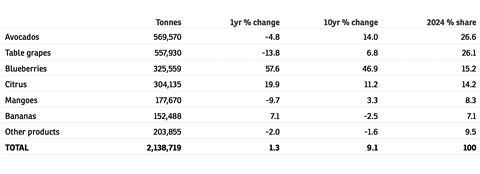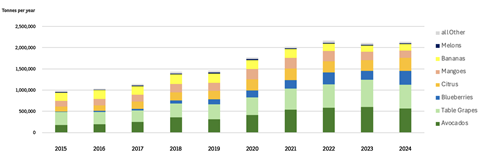Recent poor weather dampened its growth, but overall the country’s export trade remains buoyant, as Wayne Prowse reports
Peru’s water management policy has enabled its fruit export business to make a big splash on the international market. Over the past two decades, massive irrigation programmes in the east have connected the arid yet fertile plains along its Pacific coast to highland rivers and tropical Amazon basin rainforest in the east. By doing so, it has created opportunities for vast horticulture developments.
The country epitomises some of the key trends in fresh produce – impressive long-term growth in avocados and blueberries, for example; and a move towards increased sales in Asia, albeit from a relatively much smaller starting point.
Europe has long been the primary destination for Peruvian fresh fruit, although in recent years the US and Canada have taken a bigger share. In 2024, Europe accounted for 41 per cent of all the country’s fruit exports, US and Canada imported 38 per cent, and 8 per cent went to Asian markets.
Avocados were the main export product by volume, followed closely by table grapes, although both have traded places for the top spot over the last decade. Blueberries now exceed citrus as Peru’s third-largest export by volume, and helped by a higher unit value they are now the top-earning export at US$2.3bn.
In 2024, Peru’s total fresh fruit exports increased by just 1.3 per cent to 2.1mn tonnes. That result was influenced by a decline in avocados, table grapes and mangoes, but those declines were largely offset by a strong increase for blueberries and citrus. The ten-year trend for fresh fruit exports is +9.1 per cent per year (CAGR).


Avocados
Avocados are Peru’s largest fruit export by volume and account for 27 per cent of its total fresh fruit exports. The country exported 569,570 tonnes in 2024, 4.8 per cent down on the year and breaking a long-running growth streak. Adverse weather, including high temperatures and heavy rainfall, affected production in several areas, but the industry expects to bounce back in 2025.
Europe is the lead destination, taking 63 per cent of avocado exports, followed by Latin America (mostly Chile), the US, and Asia, where China and Japan are the principal markets.


Table grapes
Peru sends more than 58 varieties of table grape to various international markets. Sweet Globe, Autumn Crisp, and Red Globe are the three most popular varieties exported, according to the Provid bulletin.
The country’s table grape exports fell by 14 per cent to 557,930 tonnes in 2024, after the production season was hit by poor weather conditions including extensive rainfall and high temperatures. The ten-year average annual growth rate remains around 6.8 per cent (CAGR), and exports are set to rebound to more than 650,000 tonnes in 2025, which should return them to that longer-term trajectory.
Peru exports almost half of its table grapes to the US and Canada, plus a little over a quarter to Europe during the September to March harvest season. This trade to Europe has increased steadily by around 9 per cent per year over the past decade.
Conversely, trade with Asian markets including China and Thailand has fallen during the last ten years, and now accounts for less than 10 per cent of exports, or 43,000 tonnes, down from a 40 per cent share of the export trade in 2015.

Blueberries
With support from government incentives, Peru has exploited the temperate climate along its drier coast to develop blueberry production, using varieties that are suitable for harvesting from August to November. This follows the Northern Hemisphere seasons in the US and Europe, and thus avoids direct competition. It’s a big reason why Peru has become the world’s leading blueberry exporter in under ten years.
Blueberry exports reached a record level of 325,559 tonnes in 2024, up 58 per cent year on year. Growth over the decade has averaged 47 per cent per year.
Around 55 per cent of Peru’s blueberries are sold to the US and Canada, and 28 per cent to Europe. Both markets have recorded over 40 per cent growth per year in those ten years.
Asian markets – mainly Hong Kong and China – are smaller, and together account for 14 per cent of exports. But they are growing even faster, at 80 per cent per year over the previous ten years to 45,718 tonnes in 2024.

Mangoes
One of Peru’s iconic tropical fruits, mangoes are enjoyed both locally and internationally. They have been an export basket staple for many years, but growth has been very modest at 3 per cent per year over ten years, to 177,670 tonnes in 2024.
Exports have actually fallen 30 per cent from a peak of 250,000 tonnes in 2021, largely due to adverse conditions in the 2023/24 harvest season. However, that business is apparently on track to rebound to around 260,000 tonnes in 2025.
Around 53 per cent of Peruvian mangoes are shipped to Europe, and 37 per cent to the US and Canada. Trade to Asia, mostly South Korea, has increased off a small base to 5,000 tonnes, or 3 per cent of exports.

Bananas
While small compared with neighbouring Ecuador, Peru’s banana trade accounts for 7 per cent of its fruit exports. In 2024, it exported 152,000 tonnes of bananas, down 7 per cent compared with the previous year. Europe accounted for 60 per cent of that volume, followed by the US and Canada with 20 per cent, and Asia with 10 per cent.
As with other products, the weather affected results in 2024, although over the longer term banana exports have been relatively stable at around 200,000 tonnes per year.






